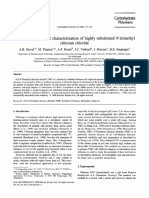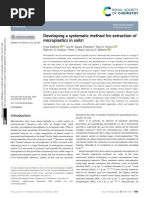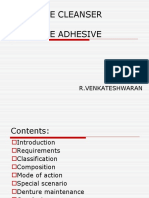Hiv 2
Hiv 2
Uploaded by
Gmo AnraCopyright:
Available Formats
Hiv 2
Hiv 2
Uploaded by
Gmo AnraCopyright
Available Formats
Share this document
Did you find this document useful?
Is this content inappropriate?
Copyright:
Available Formats
Hiv 2
Hiv 2
Uploaded by
Gmo AnraCopyright:
Available Formats
Supporting Information
Ingallinella et al. 10.1073/pnas.0901007106
SI Materials and Methods trifluoroacetica acid, 5% phenol, 2% triisopropylsilane, and 5%
Peptide Synthesis. All peptides were synthesized by solid phase water for 1.5 h at room temperature. Each resin was filtered, and
using Fmoc/tBu chemistry on a peptide synthesizer ABI433A the solution was added to cold methyl-t-butyl ether to precipitate
(Applied Biosystems). For each peptide 0.75 g of resin Fmoc- the peptide. After centrifugation, the peptide pellets were
Linker AM-Champion, 1% cross-linked (Biosearch Technolo- washed with fresh cold methyl-t-butyl ether to remove the
gies) was used. The acylation reactions were performed for 60 organic scavengers. The process was repeated twice. Final pellets
min with 4-fold excess of activated amino acid over the resin-free were dried, resuspended in H2O and 20% acetonitrile, and
lyophilized.
amino groups. The amino acids were activated with equimolar
The crude peptides were purified by reverse-phase HPLC
amounts of 2-(1H-benzotriazole-1-yl)-1,1,3,3-tetramethyluronium
using semipreparative Waters RCM Delta-Pak C4 cartridges
hexafluorophosphate (HBTU; Novabiochem) and a 2-fold molar (25 ⫻ 200 mm, 15 m) and using as eluents (A) 0.1% triflu-
excess of N,N-diisopropylethylamine (DIEA; Sigma–Aldrich) in oroacetic acid in water and (B) 0.1% trifluoroacetic acid in
dimethylformamide (DMF). acetonitrile, flow rate 30 mL/min. Analytical HPLC was per-
The side chain protecting groups were: tert-butyl for Asp, Glu, formed on a Phenomenex Jupiter C4 column (150 ⫻ 4.6 mm, 5
Ser, and Thr; trityl for Asn, Cys, His, and Gln; tert-butoxy-carbonyl m), flow rate 1 mL/min. The purified peptides were charac-
for Lys, Tyr, and Trp; and 2,2,4,6,7-pentamethyldihydrobenzofu- terized by liquid chromatography–mass spectrometry using a
ran-5-sulfonyl for Arg. Lys(N-palmitoyl) (Bachem) was used as Waters–Micromass LCZ platform.
C-terminal residue for the synthesis of C34-Pam. N-terminal acet-
ylation was performed at the end of the peptide assembly by Synthesis of Cholest-5-en-3-yl Bromoacetate (1). The synthetic
reaction with a 10-fold excess of acetic anhydride in DMF. scheme for the preparation of the precursor for chemoselective
At the end of the synthesis, the dry peptide–resins were incorporation of cholesterol into cysteine-containing peptides is
treated individually with 20 mL of the cleavage mixture, 88% outlined below.
H H
OH
DIPC, DMAP
Br + H H
O
H H
O 48h r.t. Br
HO O 73%
Bromoacetic acid Cholesterol Cholest-5-en-3-yl bromoacetate (1)
A mixture of 100 mg of cholesterol (Sigma–Aldrich) and 40 mg resulting cholesteroylated peptide was purified by reverse-phase
of bromoacetic acid (1.1 eq) (Sigma–Aldrich) was dissolved in 10 HPLC with semipreparative Waters RCM Delta-Pak C4 car-
mL of anhydrous CH2Cl2. Then 44 L (1.1 eq) of N,N- tridges (25 ⫻ 200 mm, 15 m), using as eluents (A) 0.1%
diisopropylcarbodiimide (DIPC; Sigma–Aldrich) and 1.5 mg trifluoroacetic acid in water and (B) 0.1% trifluoroacetic acid in
(0.05 eq) of 4-dimethylaminopyridine (DMAP; Novabiochem) acetonitrile, and an isocratic step at 50% (B) for 5 min followed
were added. The solution was left stirring at room temperature by the linear gradient: 50–70% (B) in 20 min to 80% (B) in 3 min,
for 48 h and analyzed by TLC (30% CH2Cl2 in hexane). washing step at 80% (B) for 3 min, flow 30 mL/min. The purified
Afterward, the solvent was removed under vacuum, and the peptide was characterized by HPLC/MS on a Waters–Micromass
crude was purified by flash column chromatography on silica gel LCZ platform (theoretical molecular mass, 5,020.7 Da; found,
(BIOTAGE) with a gradient of 10–30% CH2Cl2 in petroleum 5,020.0 Da).
ether to obtain 95 mg of the desired compound (1) as colorless
oil (yield: 73%). The purified product was analyzed by NMR. Synthesis of Chol-C34. Similarly to the synthesis of C34-Chol,
Chol-C34 was prepared by conjugation between the Cys-peptide
Synthesis of C34-Chol. C34-Cholesterol was prepared by chemo- precursor (Ac-CGSGWMEWDREINNYTSLIHSLIEESQN-
selective thioether conjugation between the Cys-peptide precur- QQEKNEQELL) and the cholesterol derivative (1). In partic-
sor (Ac-WMEWDREINNYTSLIHSLIEESQNQQEKNEQ- ular, 6.5 mg of purified Cys-peptide precursor (1.41 mol) was
ELLGSGC) and the cholesterol derivative (1). In particular, 12 dissolved in 400 L of DMSO, and 0.9 mg of (1) (1.77 mol, 1.2
mg of purified Cys-peptide precursor (2.61 mol) was dissolved eq), dissolved in 150 L of THF, was added. Then 5 L (1% by
in 600 L of DMSO, and 1.59 mg of (1) (3.13 mol, 1.2 eq), volume) of DIEA was added to the mixture, which was left
dissolved in 100 L of THF, was added. Then 7 L (1% by stirring at room temperature.
volume) of DIEA was added to the mixture, which was left After a 1-h incubation, the reaction was complete, and the
stirring at room temperature. The reaction was monitored by resulting cholesteroylated peptide was purified as described
liquid chromatography–mass spectrometry using a Waters– above. The purified peptide was characterized by HPLC/MS
Micromass LCZ platform with a Phenomenex Jupiter C4 column (theoretical molecular mass, 5,020.7 Da; found, 5,020.3 Da).
(150 ⫻ 4.6 mm, 5 m) using as eluents (A) 0.1% trifluoroacetic
acid in water and (B) 0.1% trifluoroacetic acid in acetonitrile, Synthesis of T20-Chol. Similarly to the synthesis of C34-Chol,
and the following linear gradient: 30–70% (B) in 20 min to 80% T20-Chol was prepared by conjugation between the Cys-peptide
(B) in 3 min, washing step at 80% (B) for 3 min, flow 1 mL/min. precursor (Ac-YTSLIHSLIEESQNQQEKNEQELLELDK-
After a 1-h incubation, the reaction was complete, and the WASLWNWFGSGC) and the cholesterol derivative (1). In
Ingallinella et al. www.pnas.org/cgi/content/short/0901007106 1 of 4
particular, 10.1 mg of purified Cys-peptide precursor (2.11 mol) SLIEESQNQQEKNEQELLGSGC) with iodoacetamide. In
was dissolved in 500 L of DMSO, and 1.18 mg of (1) (2.53 mol, particular, 10.2 mg of purified Cys-peptide precursor was dis-
1.1 eq), dissolved in 260 L of THF, was added. Then 8 L (1% solved in 1 mL of 6 M guanidine chloride, 0.25 M Tris, 2 mM
by volume) of DIEA was added to the mixture, which was left EDTA (pH 7.5). Then 6.0 mg of iodoacetamide (10 eq), dis-
stirring at room temperature. solved in 200 L of DMSO, was added.
After a 1-h incubation, the reaction was complete, and the After a 1-h incubation, the product was purified by reverse-
resulting cholesteroylated peptide was purified as described phase HPLC. The purified peptide was characterized by
above. The purified peptide was characterized by HPLC/MS HPLC/MS (theoretical molecular mass, 4,651.1 Da; found,
(theoretical molecular mass, 5,223.0 Da; found, 5,221.6 Da).
4,650.0 Da).
Synthesis of C34-Acm. C34-Acm was prepared through reaction of
the Cys-peptide precursor (Ac-WMEWDREINNYTSLIH-
Ingallinella et al. www.pnas.org/cgi/content/short/0901007106 2 of 4
Fig. S1. Mechanism of action of C34-Chol. (Upper) Cells are incubated with C34 or C34-Acm and then washed thoroughly before addition of the virus. In this
condition, most of the inhibitor is removed before initiation of the infection and cannot interfere with transition of the hairpin intermediate to the 6-helix bundle
postfusion structure. (Lower) C34-Chol binds to the raft comparments of the membrane during the incubation, and because of its high affinity for this
compartment, it is not removed during the washing step, remaining available for inhibition.
Ingallinella et al. www.pnas.org/cgi/content/short/0901007106 3 of 4
Table S1. Pharmacokinetic parameters of C34-Acm and C34-Chol in mice
C34-Acm C34-Chol
Parameter s.c. i.v. s.c. i.v.
Cmax, M 1.0 2.1
Tmax, h 0.8 3.0
AUC(03⬁), mM䡠h 1.4 0.7 13.9 18.9
t1/2, h 0.8 0.6 6.5 3.0
Vd, L/kg 0.21 0.03
Cl, mL/min/kg 5.7 0.2
In addition to the subcutaneous (s.c., 3.5 mg/kg) administration shown in Fig. 2, intravenous (i.v., 1 mg/kg)
administration was also performed. The vehicle was 10 mM glycine buffer (pH 10.2), 10% ethanol.
Ingallinella et al. www.pnas.org/cgi/content/short/0901007106 4 of 4
You might also like
- European Journal of Biochemistry - August 1974 - EBELING - Proteinase K From Tritirachium Album LimberNo ratings yetEuropean Journal of Biochemistry - August 1974 - EBELING - Proteinase K From Tritirachium Album Limber7 pages
- Liquid Chromatographic Determination of Biogenic Amines in A Meat Product During Fermentation and Long-Term StorageNo ratings yetLiquid Chromatographic Determination of Biogenic Amines in A Meat Product During Fermentation and Long-Term Storage9 pages
- To Whom Reprint Requests Should Be AddressedNo ratings yetTo Whom Reprint Requests Should Be Addressed11 pages
- CMDC 200900389 SM Miscellaneous InformationNo ratings yetCMDC 200900389 SM Miscellaneous Information22 pages
- Synthesis 2,4,6 Triformylphloroglucinol 2No ratings yetSynthesis 2,4,6 Triformylphloroglucinol 215 pages
- Properties of Chitosanase From Bacillus Cereus S1No ratings yetProperties of Chitosanase From Bacillus Cereus S14 pages
- Aspergillus Fumigatus: Novel Reduction and Hydroxylation Products Formed by From Reichstein's Substance SNo ratings yetAspergillus Fumigatus: Novel Reduction and Hydroxylation Products Formed by From Reichstein's Substance S5 pages
- Journal of Bacteriology-1991-Kordel-4836.fullNo ratings yetJournal of Bacteriology-1991-Kordel-4836.full6 pages
- Synthesis of Novel Quaternary Chitosan Derivatives ViaNo ratings yetSynthesis of Novel Quaternary Chitosan Derivatives Via4 pages
- Synthesis Characterization Oc-Adrenoceptors Parotid Slices Human MembranesNo ratings yetSynthesis Characterization Oc-Adrenoceptors Parotid Slices Human Membranes5 pages
- Polyhydroxyalkanoate (PHA) Biosynthesis In: Purification and Biochemical Properties of PHA SynthaseNo ratings yetPolyhydroxyalkanoate (PHA) Biosynthesis In: Purification and Biochemical Properties of PHA Synthase12 pages
- Desalting Plasma Protein Solutions by Membrane Capacitive DeionizationNo ratings yetDesalting Plasma Protein Solutions by Membrane Capacitive Deionization22 pages
- Aim: To Analyze in Vitro Metabolism of AminopyrineNo ratings yetAim: To Analyze in Vitro Metabolism of Aminopyrine22 pages
- Acetaminophen Prodrugs: Synthesis, Physicochemical Properties, and Analgesic ActivityNo ratings yetAcetaminophen Prodrugs: Synthesis, Physicochemical Properties, and Analgesic Activity7 pages
- Purification and Characterization of An Extracellular Agglutinin From Containing GlycoconjugatesNo ratings yetPurification and Characterization of An Extracellular Agglutinin From Containing Glycoconjugates8 pages
- Inhibition of Tetrahydrolipstatin: Pancreatic inNo ratings yetInhibition of Tetrahydrolipstatin: Pancreatic in5 pages
- Hplc-Dad With Different Types Of Column For Determination Of Β-Cyfluthrin In Pesticide FormulationsNo ratings yetHplc-Dad With Different Types Of Column For Determination Of Β-Cyfluthrin In Pesticide Formulations14 pages
- (F) - 5-Fluoro-5-Deoxyribose, An Efficient Peptide Bioconjugation Ligand For Positron Emission Tomography (PET) ImagingNo ratings yet(F) - 5-Fluoro-5-Deoxyribose, An Efficient Peptide Bioconjugation Ligand For Positron Emission Tomography (PET) Imaging17 pages
- By Using RP-HPLC Technique, Quantitative and Qualitative Analysis of Gallic Acid From Industrial WasteNo ratings yetBy Using RP-HPLC Technique, Quantitative and Qualitative Analysis of Gallic Acid From Industrial Waste4 pages
- Conjugated Microporous Polymers-CatalyzedNo ratings yetConjugated Microporous Polymers-Catalyzed60 pages
- Anie201610462 Sup 0001 Misc Information1No ratings yetAnie201610462 Sup 0001 Misc Information131 pages
- Hydrolysis Kinetics of Thifensulfuron Methyl in Aqueous Buffer SolutionsNo ratings yetHydrolysis Kinetics of Thifensulfuron Methyl in Aqueous Buffer Solutions5 pages
- DPPH Radical-Scavenging Compounds From Dou-Chi, A Soybean Fermented FoodNo ratings yetDPPH Radical-Scavenging Compounds From Dou-Chi, A Soybean Fermented Food0 pages
- Chemesthesis: Chemical Touch in Food and EatingFrom EverandChemesthesis: Chemical Touch in Food and EatingShane T. McDonaldNo ratings yet
- Sustainable synthesis of ciclopentene derivatives through multicomponent reactions in continuous flow regimeFrom EverandSustainable synthesis of ciclopentene derivatives through multicomponent reactions in continuous flow regimeNo ratings yet
- Hyaluronic Acid: Production, Properties, Application in Biology and MedicineFrom EverandHyaluronic Acid: Production, Properties, Application in Biology and MedicineNo ratings yet
- Co- and Post-Translational Modifications of Therapeutic Antibodies and ProteinsFrom EverandCo- and Post-Translational Modifications of Therapeutic Antibodies and ProteinsNo ratings yet
- Addition of A Cholesterol Group To An HIV-1 Peptide Fusion Inhibitor Dramatically Increases Its Antiviral PotencyNo ratings yetAddition of A Cholesterol Group To An HIV-1 Peptide Fusion Inhibitor Dramatically Increases Its Antiviral Potency6 pages
- Genomic Islands: Tools of Bacterial Horizontal Gene Transfer and EvolutionNo ratings yetGenomic Islands: Tools of Bacterial Horizontal Gene Transfer and Evolution18 pages
- Physiological Functions of Mineral Macronutrients: Frans JM MaathuisNo ratings yetPhysiological Functions of Mineral Macronutrients: Frans JM Maathuis9 pages
- Effect of Bioregulators On Growth and Yield of Chickpea (Cicer Arietinum L.)No ratings yetEffect of Bioregulators On Growth and Yield of Chickpea (Cicer Arietinum L.)4 pages
- Organic Chemistry - Some Basic Principles and Techniques: Unit 12No ratings yetOrganic Chemistry - Some Basic Principles and Techniques: Unit 1230 pages
- Developing A Systematic Method For Extraction of Microplastics From SoilNo ratings yetDeveloping A Systematic Method For Extraction of Microplastics From Soil11 pages
- IS:1460 (2005) Automotive Diesel Fuel SpecificationsNo ratings yetIS:1460 (2005) Automotive Diesel Fuel Specifications23 pages
- Sherwin-Williams Primer E67BC1704 20141007 PDFNo ratings yetSherwin-Williams Primer E67BC1704 20141007 PDF2 pages
- Techno-Economic Assessment About Silica GelNo ratings yetTechno-Economic Assessment About Silica Gel3 pages
- Biomolecules _ DPP 01 (of Lecture 02) __ Arjuna NEET 2025No ratings yetBiomolecules _ DPP 01 (of Lecture 02) __ Arjuna NEET 20253 pages
- Ch1. Classification Biology Cousebook IGCSENo ratings yetCh1. Classification Biology Cousebook IGCSE10 pages
- Denture Cleanser & Denture Adhesive: BY, R.VenkateshwaranNo ratings yetDenture Cleanser & Denture Adhesive: BY, R.Venkateshwaran77 pages
- The Synthesis of Adipic Acid From Cyclohexene Utilising Green ProceduresNo ratings yetThe Synthesis of Adipic Acid From Cyclohexene Utilising Green Procedures169 pages
- (Annual Reports On NMR Spectroscopy 1) E.F. Mooney (Eds.) - Elsevier, Academic Press (1968) PDFNo ratings yet(Annual Reports On NMR Spectroscopy 1) E.F. Mooney (Eds.) - Elsevier, Academic Press (1968) PDF365 pages
- Analisis Penggunaan Beberapa Jenis Kemasan Plastik Terhadap Umur Simpan Sayur Selada (Lactuca Sativa L) Selama Penyimpanan DinginNo ratings yetAnalisis Penggunaan Beberapa Jenis Kemasan Plastik Terhadap Umur Simpan Sayur Selada (Lactuca Sativa L) Selama Penyimpanan Dingin9 pages
- SANTOL (Sandoricum Koetjape) AND LANZONES (Lansium Domesticum) SEEDS As An Alternative FuelNo ratings yetSANTOL (Sandoricum Koetjape) AND LANZONES (Lansium Domesticum) SEEDS As An Alternative Fuel14 pages
- European Journal of Biochemistry - August 1974 - EBELING - Proteinase K From Tritirachium Album LimberEuropean Journal of Biochemistry - August 1974 - EBELING - Proteinase K From Tritirachium Album Limber
- Liquid Chromatographic Determination of Biogenic Amines in A Meat Product During Fermentation and Long-Term StorageLiquid Chromatographic Determination of Biogenic Amines in A Meat Product During Fermentation and Long-Term Storage
- Aspergillus Fumigatus: Novel Reduction and Hydroxylation Products Formed by From Reichstein's Substance SAspergillus Fumigatus: Novel Reduction and Hydroxylation Products Formed by From Reichstein's Substance S
- Synthesis of Novel Quaternary Chitosan Derivatives ViaSynthesis of Novel Quaternary Chitosan Derivatives Via
- Synthesis Characterization Oc-Adrenoceptors Parotid Slices Human MembranesSynthesis Characterization Oc-Adrenoceptors Parotid Slices Human Membranes
- Polyhydroxyalkanoate (PHA) Biosynthesis In: Purification and Biochemical Properties of PHA SynthasePolyhydroxyalkanoate (PHA) Biosynthesis In: Purification and Biochemical Properties of PHA Synthase
- Desalting Plasma Protein Solutions by Membrane Capacitive DeionizationDesalting Plasma Protein Solutions by Membrane Capacitive Deionization
- Aim: To Analyze in Vitro Metabolism of AminopyrineAim: To Analyze in Vitro Metabolism of Aminopyrine
- Acetaminophen Prodrugs: Synthesis, Physicochemical Properties, and Analgesic ActivityAcetaminophen Prodrugs: Synthesis, Physicochemical Properties, and Analgesic Activity
- Purification and Characterization of An Extracellular Agglutinin From Containing GlycoconjugatesPurification and Characterization of An Extracellular Agglutinin From Containing Glycoconjugates
- Hplc-Dad With Different Types Of Column For Determination Of Β-Cyfluthrin In Pesticide FormulationsHplc-Dad With Different Types Of Column For Determination Of Β-Cyfluthrin In Pesticide Formulations
- (F) - 5-Fluoro-5-Deoxyribose, An Efficient Peptide Bioconjugation Ligand For Positron Emission Tomography (PET) Imaging(F) - 5-Fluoro-5-Deoxyribose, An Efficient Peptide Bioconjugation Ligand For Positron Emission Tomography (PET) Imaging
- By Using RP-HPLC Technique, Quantitative and Qualitative Analysis of Gallic Acid From Industrial WasteBy Using RP-HPLC Technique, Quantitative and Qualitative Analysis of Gallic Acid From Industrial Waste
- Hydrolysis Kinetics of Thifensulfuron Methyl in Aqueous Buffer SolutionsHydrolysis Kinetics of Thifensulfuron Methyl in Aqueous Buffer Solutions
- DPPH Radical-Scavenging Compounds From Dou-Chi, A Soybean Fermented FoodDPPH Radical-Scavenging Compounds From Dou-Chi, A Soybean Fermented Food
- Chemesthesis: Chemical Touch in Food and EatingFrom EverandChemesthesis: Chemical Touch in Food and Eating
- Sustainable synthesis of ciclopentene derivatives through multicomponent reactions in continuous flow regimeFrom EverandSustainable synthesis of ciclopentene derivatives through multicomponent reactions in continuous flow regime
- Hyaluronic Acid: Production, Properties, Application in Biology and MedicineFrom EverandHyaluronic Acid: Production, Properties, Application in Biology and Medicine
- Co- and Post-Translational Modifications of Therapeutic Antibodies and ProteinsFrom EverandCo- and Post-Translational Modifications of Therapeutic Antibodies and Proteins
- Addition of A Cholesterol Group To An HIV-1 Peptide Fusion Inhibitor Dramatically Increases Its Antiviral PotencyAddition of A Cholesterol Group To An HIV-1 Peptide Fusion Inhibitor Dramatically Increases Its Antiviral Potency
- Genomic Islands: Tools of Bacterial Horizontal Gene Transfer and EvolutionGenomic Islands: Tools of Bacterial Horizontal Gene Transfer and Evolution
- Physiological Functions of Mineral Macronutrients: Frans JM MaathuisPhysiological Functions of Mineral Macronutrients: Frans JM Maathuis
- Effect of Bioregulators On Growth and Yield of Chickpea (Cicer Arietinum L.)Effect of Bioregulators On Growth and Yield of Chickpea (Cicer Arietinum L.)
- Organic Chemistry - Some Basic Principles and Techniques: Unit 12Organic Chemistry - Some Basic Principles and Techniques: Unit 12
- Developing A Systematic Method For Extraction of Microplastics From SoilDeveloping A Systematic Method For Extraction of Microplastics From Soil
- IS:1460 (2005) Automotive Diesel Fuel SpecificationsIS:1460 (2005) Automotive Diesel Fuel Specifications
- Biomolecules _ DPP 01 (of Lecture 02) __ Arjuna NEET 2025Biomolecules _ DPP 01 (of Lecture 02) __ Arjuna NEET 2025
- Denture Cleanser & Denture Adhesive: BY, R.VenkateshwaranDenture Cleanser & Denture Adhesive: BY, R.Venkateshwaran
- The Synthesis of Adipic Acid From Cyclohexene Utilising Green ProceduresThe Synthesis of Adipic Acid From Cyclohexene Utilising Green Procedures
- (Annual Reports On NMR Spectroscopy 1) E.F. Mooney (Eds.) - Elsevier, Academic Press (1968) PDF(Annual Reports On NMR Spectroscopy 1) E.F. Mooney (Eds.) - Elsevier, Academic Press (1968) PDF
- Analisis Penggunaan Beberapa Jenis Kemasan Plastik Terhadap Umur Simpan Sayur Selada (Lactuca Sativa L) Selama Penyimpanan DinginAnalisis Penggunaan Beberapa Jenis Kemasan Plastik Terhadap Umur Simpan Sayur Selada (Lactuca Sativa L) Selama Penyimpanan Dingin
- SANTOL (Sandoricum Koetjape) AND LANZONES (Lansium Domesticum) SEEDS As An Alternative FuelSANTOL (Sandoricum Koetjape) AND LANZONES (Lansium Domesticum) SEEDS As An Alternative Fuel





























































































